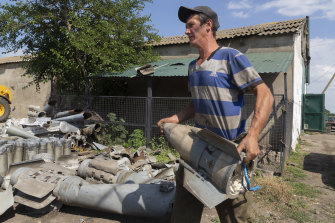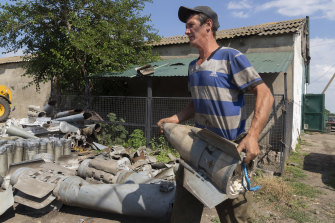[ad_1]
For now, Ukraine is trying less-effective alternatives to export its grain, at least to Europe. Currently, 30 per cent of exports go via three Danube River ports in south-western Ukraine.
The country also is trying to ship grain via 12 border crossings with European countries, but trucks must wait in line for days, and Europe’s infrastructure cannot yet absorb such a volume of grain, Horbachov said.

A farmer collects fragments of Russian rockets that he found on his field ten kilometres from the front line in the Dnipropetrovsk region.Credit:AP
“It’s impossible to build such infrastructure in one year,” he said.
Russia’s invasion also caused transportation costs to soar. The price to deliver this year’s harvested barley to the closest Romanian port, Constanta, is now $US160 to $US180 per tonne, up from $US40 to $US45. And yet a farmer selling barley to a trader gets less than $US100 per tonne.
The losses are piling up, along with the harvest.
“Most of the farmers are running the risk of becoming bankrupt very soon. But they don’t have any other option but to sell their grain cheaper than its cost,” Horbachov said.
On top of such challenges, not all farmers can sell their grain.
Before the invasion, Chubuk could sell a tonne of wheat from his Kyiv region farm for $US270. Now he can’t find a buyer even at $US135 per tonne.
“The whole system backs up,” including storage options, said James Heneghan, senior vice president at Gro Intelligence, a global climate and agriculture data analytics company. The system was meant to keep Ukraine’s exports flowing, not store them.
Loading
Without money coming in for grain, future harvests are challenging. “Farmers need to purchase fertilisers, seeds, diesel, pay the salary,” Horbachov said. “Ukrainian farmers can’t print money.”
The country hasn’t yet run out of storage as the harvest begins.
Ukraine has about 65 million to 67 million tonnes of commercial grain storage capacity, according to Horbachov, although 20 per cent of that is in Russian-occupied territories. Farmers themselves can store 20 million to 25 million tonnes, but some of that is also in occupied areas.
By the end of September, when the harvest of corn and sunflower seeds begins, Ukraine will face a shortage of storage capacity.
The FAO recently announced a $US17 million project to help address the storage deficit. Heneghan of Gro Intelligence noted that one temporary solution could be providing farmers with silo bags for storage.
In eastern and southern regions near the front line, farmers continue to work their fields despite the threat to their lives.
“It can be finished in a moment by bombing, or as we see now, the fields are on fire,” said Yurii Vakulenko in the Dnipropetrovsk region, black smoke visible in the distance.
His workers risk their lives for little return, with storage facilities now refusing to take their grain, Vakulenko said.
Loading
Ukraine had a record-breaking grain harvest last year, collecting 107 million tonnes. Even more had been expected this year.
Now, in the best-case scenario, farmers will harvest only 70 million tonnes of grain this year, Horbachov estimated.
“Without opening the [Black Sea] ports, I don’t see any solution for Ukrainian farmers to survive,” he said. “And if they don’t survive, we won’t be able to feed African countries.”
AP

